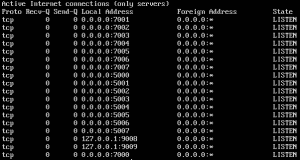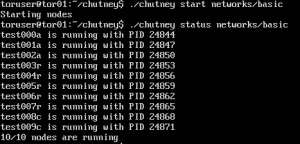BSidesROC is over. I thought it might be interesting to give a behind-the-scenes look at some of the stuff that makes BSidesROC run.
OPs
We have “Ops”. A few years ago we decided to try to organize BSides like an IRC network where each channel has an Op and an Op controls what happens in that channel. So for us Ops are trusted volunteers, and the channels are facets of BSidesROC such as the website, Hacker Battleship, or T-shirts. This is a cheeky way of letting people manage stuff they want to manage. So when someone says “Man the website is great!” We can say – well you should thank the Website Op. But that also means, “Hey can you put this on the website,” it’s expected that the Website Op handles this.
So this is why Ops are an important part of BSidesROC. For the most part they need to manage their respective channel (with the support of the rest of the group). They’re also under a lot of pressure because if something goes terribly, they go down with their ship. 🙂
Our Venue
Some of you know that we needed to switch venues this year. That’s because our last spot at the Auditorium Center turned into a full blown church. I’m happy with the results at the German House. It required some extra money and logistics but the end result was what I would describe as more “adult.” It’s a legitimate venue as opposed to the ad-hoc setup that we did at the Auditorium. I was very nervous about traffic flow at The German House but attendees seemed to manage it alright.
One interesting issue was that at 4pm, what we labelled Track 1 needed to turn instantly back into a restaurant. So while the rest of the conference finished up, Zeppa was opening up shop downstairs. That made it a little stressful but everyone was awesome enough to make it work.
Tor and Privacy
I’ll be honest, I did not know how well a Tor talk was going to be received at BSidesROC. That is until I showed up to give my presentation to a packed room. The backgrounds were pretty wide. Some people I spoke with before the talk honestly admitted that they knew that Tor was a tool for anonymity, but not sure how it worked. Others said they have been using Tor for a long time and had even given presentations on the topic before. If I could do it again, I would probably spit it up into an Introduction to Tor and an Advanced Tor talk. I’d really love to hear from people that are working on Tor related things in the Rochester area. Get in touch if you are.
Financials
I haven’t really been asked about money, but I do think it’s important to be transparent about where it goes. Primarily to show that we’re not lying when we say that we are a 100% volunteer organization. I’d rather not give itemized details about venue and food, just in case Zeppa doesn’t want that information public but I’m happy to share other data.
- 100% of cash goes into the organization. No one is paid a dollar.
- At the beginning of the year, we try to budget a small portion for “infrastructure” such as new projectors, better screens, etc. This year, this was radios that ended up being a life saver.
- The biggest line item this year was food costs. The second biggest item was venue costs.
- None of the speakers were paid. 🙁 If we had more money, we would have.
- At the end of the conference every year, we have little more than a few hundred dollars left in the bank.
- We aren’t lying when we say sponsors are important to us
Food and Tickets
When people purchased a Breakfast, Lunch, or All The Things! ticket, BSidesROC paid for most of your meal. That meant that whenever someone bought a meal ticket, we had to pay more money. The problem with this is that it didn’t scale to the 250-300 attendees that we had. If everyone bought a food ticket with those numbers, we would have lost at least $5000 when the event was over. So that’s the main reason we had to stop selling tickets.
2 Weeks prior to the event, we had sold 115 tickets. When we saw that in the last 2 weeks, we sold over 150 more tickets, we got very scared about food. We didn’t want people to have to wander around the city not knowing where to go and we didn’t want people to have to go to a restaurant and sit for an hour to get fed. So one of the volunteers, Pee, said “We should get food trucks next year.” To which I replied, “Why not this year?” It turned out to be a great idea because Hello Arepa and Marty’s Meats did a great job at feeding the flood of people that poured out in the afternoon. I think we’ll modify our food options next year to play better into what attendees are willing to pay and still find a way of predicting how many people will be arriving the day of the conference.
Parking
Parking has always sucked at BSidesROC let’s be honest. Last year we had a case where people parked in the wrong place and got towed. This year we had an angry church lady yelling at our people. Just to share some info, Zeppa had let us know that there were 3 spots to park. The main parking lot, the one on South Ave, and then the church. But once again, a church got in our way. 🙂 I don’t know why, but the church decided it didn’t want to allow any attendees to park there. When I spoke to Zeppa they freaked out and ran over there to fix it. Unfortunately it was too late. Most of the people had to find other parking.
Hiring and Sponsoring
One of my goals last year was to do a hiring station. Somehow figure out how to tie employers that are hiring, to people looking to get hired. It turns out this is a really difficult problem to coordinate. Between figuring out an appropriate style of the event and talking with companies, the logistics are overwhelming. We’re still trying to stick this for next year but if someone has an idea, please email me.
Hacker Battleship
I really like the idea of hacker battleship (but I’m biased of course) and I think a lot of people do too. Especially college students. It’s a fun game. The problem was this year they re-used some of the challenges from last year and the game didn’t work for a variety of reasons, etc . It needs some help. Our hacker battleship op (who is also in charge of a dozen other things) could use some help if someone wanted to join in for next year.
Shirts and Doge
The shirts this year were Doge Meme based. This meme is still funny to me so I worked with local designer, Brian Boucheron to put them together. We didn’t plan on the insane draw of Dogecoin especially for my Doge Dancers that entertained us at the end of the day. If you missed it, I’m sorry. 🙂
 Use case
Use case